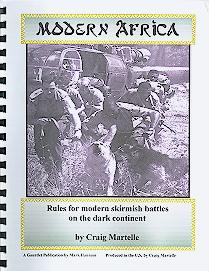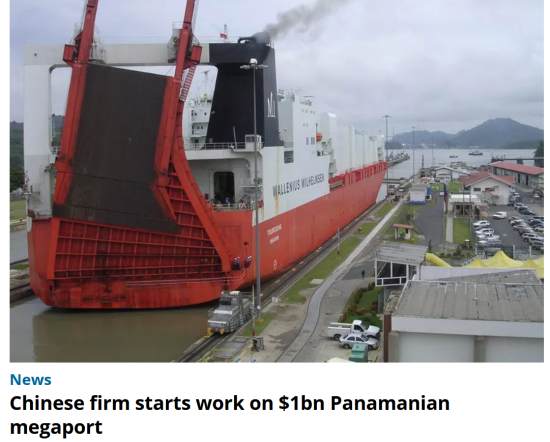
Rules for modern skirmish battles on the dark continent
Description
I designed Modern Africa to be a combination of quick play, yet achieve a level of realism… getting the new Peter Pig figures onto the table top is the most important factor.
– Designer's Notes, Modern Africa, pg. 26
Modern Africa is a set of skirmish rules for post-WWII Africa, intended to portray small-scale clashes between warlords, dictators, and Westerners.
The arms were either leftovers from an earlier era, state-sponsor (U.S. or USSR) supplied, or black market purchased. These are not the latest, greatest weaponry and they may not even be wielded by trained soldiers, but the goal was always freedom.
– Introduction, Modern Africa, pg. 3
Ragtag Forces
A player's force may consist of Leaders, Infantry, Weapon Teams, or Vehicles.
- Leaders come in three varieties – Leaders/Elders, the overall commanders; Lieutenants/Baas, assistant commanders; and Sergeants/Bwanas, replacements for dead Lieutenants.
- Infantry differ in their level of training (militia, regular, elite) and their weaponry. In the context of this game, "elite" usually refers to Western troops.
- Weapon Teams consist of a weapon/gun and crew (machineguns, recoilless rifles, anti-tank guns)
- Vehicles are classified as armored fighting vehicles, trucks (military or civilian), technicals (civilian trucks with weapons mounted), and vans.
All units are assigned to a leader, and form his command.
Sequence of Play
Both players participate in each turn, which is composed of these steps:
- check command and control
- track artillery
- issue orders
- reveal orders
- execute orders
- Attack
- Charge
- Move
- Reorganize
- off-board actions
- reactive fire
- check morale
Several of these steps can usually be skipped. Tracking Artillery is only used under the Advanced Rules. Off-Board Actions is when scenario-specific rules allow reinforcements to arrive, unless the Advanced Rules are in play. Reactive Fire is a special combat phase that occurs only due to bad luck previously in the turn.
During the Command and Control phase, units are checked to see if they are "in control." A dieroll is made for each Lieutenant and Sergeant to see if they are functioning this turn. (Leaders/Elders are always functioning.) To be "in control," a unit must be within command range of a functioning leader. Leaders may use radios to extend their command range.
Orders are issued by placing counters face-down next to each stand. Uncontrolled units cannot be given any orders. Orders are "revealed" by flipping the counters face-up. The possible orders are:
- attack
- charge
- move
- reorganize
- defend
- dummy (blank - "no orders")
When an Attack order is revealed, the player has the option to declare a Grenade Attack instead of using that stand's default weaponry. The attack is resolved during the Execute Orders phase.
A player who knows he is sending a unit out of command range may give that unit a Static Order. This must be a simple action, such as defending or seizing a specific objective. The unit will then attempt to follow that order, even when uncontrolled.
Execution of Orders
This is where the action takes place. All actions are considered to be simultaneous.
– Turn Sequence, Modern Africa, pg. 8
All units have two movement ratings – for clear and rough terrain. Movement penalties apply to units with Defend orders, damaged units, and disembarking units. Units with a Move order must move at least 1" in any direction, and must state where they intend to move before measurement occurs and the pieces are moved.
Because of the poor state of repair, age, and other factors, armored vehicles are less reliable off-road than a Toyota truck, for instance.
– Observation, Modern Africa, pg. 15
Whenever a vehicle moves from clear to rough terrain, it must make a Difficulty Check. (Difficulty Checks are made for anything "out of the ordinary," including artillery requests and radio communications.) Vehicles which fail the check "…blow a tire, drop an axle, etc." As the designer's notes explain, most African forces are operating with an extreme lack of spare parts, and so breakdowns are common.

Units with Attack orders may fire on their enemies. (However, rules prohibit firing on leaders unless they are alone.) Weapons are classified into eight types:
- Grenades (hand-thrown)
- Close-In Weapons (pistols, shotguns, submachineguns)
- Small Arms (rifles, light machineguns)
- Medium or Heavy Machineguns
- Recoilless Rifles and Anti-Tank Guns
- Anti-Tank Missiles
- Rocket-Propelled Grenades (RPGs)
- Tank Main Guns
A unit's weapon class determines its range, and what type of dice it rolls for combat – d6, d8, d10, or d12. Dieroll modifiers apply due to range (point-blank, close, long, extreme), tactical situation, training, cover, orders, target type, and damage. (This includes a bonus, both offensive and defensive, for massed troops.) A dieroll is also made for the target - usually a d6, but armored vehicles roll d8 or d10, with a bonus if under Defend orders.
The difference between the dierolls determines the number of "hits" which the target receives. If the attacker fails by 3 points or more, the defender qualifies for a free Reactive Attack during the Reactive Fire phase.
When a grenade is used, a target is chosen, and then two dierolls are made to determine if and how far the grenade scatters. If the grenade succeeds in hitting the target, an attack roll is made (without modifiers).
Melee combat occurs between opposing stands which are in contact, and if one or both stands has an Attack order. One die is rolled for both attacker and defender, with modifiers applying due to damage, cover, and whether a Charge order exists. Damage is inflicted as per the ranged combat rules. If multiple attackers gang up against a single defender, separate combats are resolved, but with a bonus applying to the attackers.
Damage and Morale
An infantry stand has 9 hits and 3 figures. For every 3 hits, it is considered to have lost a figure (the rules suggest using a pipe cleaner or other marker to indicate this). At the end of the turn, all surplus hits are erased. For instance, if an infantry stand received 4 hits in a turn, it would lose one figure (3 hits) at the moment the third hit was received, and the fourth hit would be discarded at the end of the turn.
A leader has 3 hits (1 figure). Weapon stands and vehicles have 6 hits, and receive a marker when they take the first 3 hits of damage.
Stands which have been marked for damage are considered Damaged, with combat penalties applying to it. When a stand loses all of its hits, it is "killed" and removed from play.
Damaged stands can be consolidated to form functional stands – for instance, combining a 1-figure and a 2-figure infantry stand together to form a normal 3-figure stand. To do this, the stands and a leader (non-Sergeant) must be in contact, and they must be given a Reorganize order. At the end of the turn, the damaged stands are exchanged for one undamaged stand.
During the Morale phase, units are required to "check morale" if they have lost a leader, or if their command has lost a unit. All units have the same Base Morale, modified by training, presence of the Leader/Elder, the results of the current turn, and the frequency of morale checks. A unit which fails morale changes facing, and on future turns moves until it exists the playing field.
Leaders never take morale checks, but a Lieutenant is forced to flee with his last unit if it fails morale.
Advanced Rules
The advanced rules add air cover, artillery, and mines.
Even with the slightest amount of luck, a partially successful air attack could swing the battle completely in one side's favor in a matter of moments.
– Additional/Advanced Rules, Modern Africa, pg. 19
A request for air cover is made by attempting a Difficulty Roll during the Off-Board Actions phase. If successful, five turns elapse before the mission arrives. During the Off-Board Actions phase of that turn, two dice are rolled and the appropriate table is consulted (one for African forces, one for Western forces). The results vary from plane crashing (morale penalty), friendly fire, plane never arrives, various degrees of inaccuracy, or "on time and target."
If the air mission is inaccurate, the player selects a target point, then two dice are rolled to determine where the mission scatters to. The artillery template indicates which units (friendly and enemy) are attacked. The effect is resolved by making unmodified attack rolls.
If the mission is on target, the artillery template is placed as desired, and all units within the area are removed from play.
Artillery works similarly, but the target location must be declared at the moment the request is made. Artillery arrives sooner than air strikes, and no dieroll is made against a table. Instead, dice are rolled to determine distance and direction of scatter, with "doubles" scoring a direct hit (bull's eye). The attack is resolved by making unmodified attack rolls.
Mortars operate in the same manner as artillery, but missions arrive more quickly, affect a smaller target area, and use a smaller attack die.
Mines are noted prior to play, and are either anti-tank or anti-personnel. When a unit enters a minefield, a dieroll determines whether the mines are spotted, or if damage occurs. Anti-tank mines only affect tanks/vehicles, and anti-infantry mines only affect non-vehicles.
Scenarios
The rules include two scenarios:
- Retaliation (Mogadishu, 1996)
- The Ayr sub-clan seeks to retrieve stolen trucks from the Dububle sub-clan. The Dububles have four trucks and 50 militiamen in a warehouse. The Ayr have 100 soldiers (regulars and militia) plus a machinegun crew.
FIGURES REQUIRED:
Dububle -15 x militia (AK-47), 1 x Lieutenant, 4 x trucks
Ayr - 21 x regulars (AK-47), 9 x militia (clubs), 1 x heavy machinegun and crew, 1 x Leader, 2 x Lieutenants - Ambush (Biafra, 1969)
- Federal (Nigerian) forces on the high ground ambush a Biafran Freedom Force convoy on the road. The Federal forces want to inflict damage to vital equipment, then get away.
FIGURES REQUIRED:
Federal - 15 x regulars (French rifles), 1 x heavy machinegun and crew, 2 x jeep, 2 x 57mm anti-tank gun and crew, 1 x Leader, 1 x Lieutenant
Biafran - 45 x militia, 1 x car (sedan), 10 x 2-ton trucks, 5 x BTR-40 wheeled APCs, 1 x Leader (in car), 3 x Lieutenants










